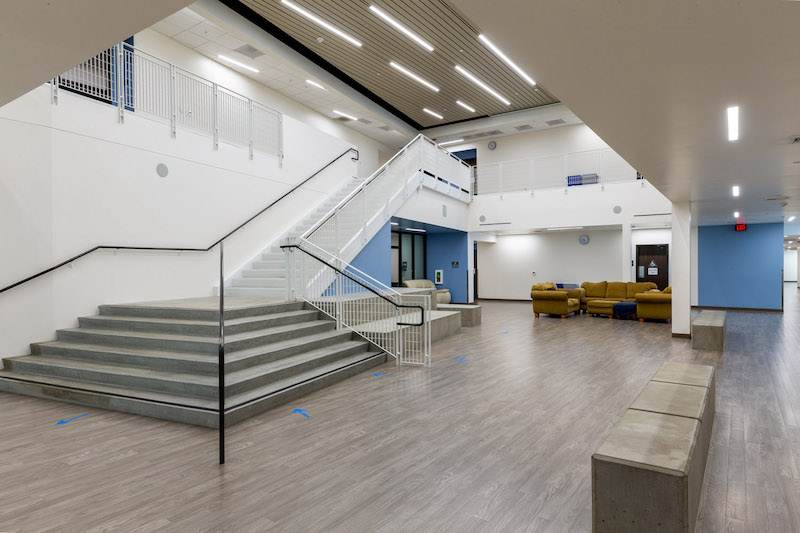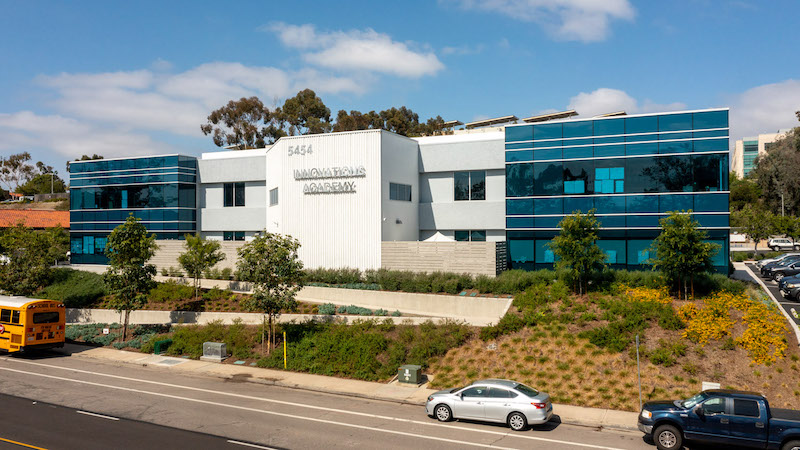The general contractor Balfour Beatty has been working with the San Diego Unified School District for 13 years. Over the past five years alone, the firm has completed five projects for the District, with number six currently under construction.
On all improvement and construction projects, the District has a mandatory goal of 50% participation by emerging business enterprises, or EBEs. That goal includes 5% for disabled veteran business enterprises (DVBEs).
For the District’s recent $38 million project that modernized its Innovations Academy, a K-8 charter school with nearly 400 students, Balfour Beatty delivered more than 62,000 sf of educational space within a tight five-month schedule. The contractor awarded $5 million in contracts, nearly 13%, to local DVBE firms, a portion that more than doubled the District’s participation goal for DVBEs. “That was outstanding,” says Tim Berry, senior vice president and one of Balfour Beatty’s K-12 market leads in California, whom BD+C interviewed earlier this week.
In total, Balfour Beatty has awarded contracts to five San Diego-area DVBE firms—Audio Associates of San Diego, IO Environmental & Infrastructure, Penn Air Control, PN Supply, and Veterans Engineering Services—that have worked on 22 projects for the District.
A SKILLED LABOR POOL
At a time when the construction industry has struggled with shortages of skilled labor, tapping the veterans’ community for workers can fill gaps for firms like Balfour Beatty. These partnerships, the firm has stated, “bring a pool of talent that is rich in leadership and complex problem-solving skillsets.”
Berry notes that over the past two decades Balfour Beatty has done a lot of work for the federal government and the military. On such projects, the vast majority of the construction is typically performed by small-business enterprises. Over this period, Balfour Beatty itself has also hired lots of vets, and continues to have a proactive outreach and networking program, particularly in southern California where there’s a large military population.
Programs that encourage, or even mandate, the hiring of veteran-owned businesses “open the door for us,” says Mike Bilodeau, CEO of IO Environmental & Infrastructure, which he started in 2007. With four offices and 50 employees, the company has grown to where it is performing jobs nationally (it currently has projects underway in North Carolina, Utah, and at Fort Dix in New Jersey.)
The San Diego Unified School District is one of IO’s long-standing clients. Ever since the District moved its properties into lease-leaseback agreements, many of its building upgrades have been whole-school remodels. “It’s almost like a design-build situation,” says Bilodeau, who served in the Coast Guard, and was also an environmental specialist with the U.S. Army Corps of Engineers.
CONSISTENT CASHFLOW A MAJOR BENEFIT

The modernization of the Innovations Academy included 27 classrooms, the gym, exterior play area and parking facilities, according to ABBA Project Management.
For the Innovations Academy project, the scope of IO’s work consisted of landscaping, irrigation, and decomposed granite resurfacing. Dan Parker, IO’s operations manager (and a U.S. Air Force vet), lauds John Atherton, MEng, CCM, DBIA, LEED AP, Balfour Beatty’s project executive, for keeping the Innovations Academy job moving forward smoothly. (Berry notes that this project required modifying the existing building’s structural component with 30- to 50-ft-deep shoring.)
To achieve dynamic DVBE participation on a hard-bid project like this one, Balfour Beatty develops targeted bid packages during preconstruction. Oftentimes, DVBEs come in as second-tier trade partners, so it’s important for the contractor to establish clear participation goals for the entire supply chain.
As consistent cashflow is of critical importance to small businesses, Balfour Beatty makes a point of paying the DVBEs it hires on time and in full. It also works with these subs to expedite the hiring process. “It’s essential that the paperwork be filled out properly, especially when financing is an issue,” explains Berry.
Balfour Beatty’s involvement with DVBEs may be about giving back to the community, and providing equal opportunities to all subcontractor companies. But the firm’s motives aren’t entirely altruistic: Berry says these partnerships help the firm grow. And the presence of vets on the jobsite can lift up the entire team. “There’s no entitlement mentality with vets, no ‘I can’t.’ ”
Related Stories
| Nov 3, 2010
Rotating atriums give Riyadh’s first Hilton an unusual twist
Goettsch Partners, in collaboration with Omrania & Associates (architect of record) and David Wrenn Interiors (interior designer), is serving as design architect for the five-star, 900-key Hilton Riyadh.
| Nov 3, 2010
Virginia biofuel research center moving along
The Sustainable Energy Technology Center has broken ground in October on the Danville, Va., campus of the Institute for Advanced Learning and Research. The 25,000-sf facility will be used to develop enhanced bio-based fuels, and will house research laboratories, support labs, graduate student research space, and faculty offices. Rainwater harvesting, a vegetated roof, low-VOC and recycled materials, photovoltaic panels, high-efficiency plumbing fixtures and water-saving systems, and LED light fixtures will be deployed. Dewberry served as lead architect, with Lord Aeck & Sargent serving as laboratory designer and sustainability consultant. Perigon Engineering consulted on high-bay process labs. New Atlantic Contracting is building the facility.
| Nov 3, 2010
Dining center cooks up LEED Platinum rating
Students at Bowling Green State University in Ohio will be eating in a new LEED Platinum multiuse dining center next fall. The 30,000-sf McDonald Dining Center will have a 700-seat main dining room, a quick-service restaurant, retail space, and multiple areas for students to gather inside and out, including a fire pit and several patios—one of them on the rooftop.
| Nov 2, 2010
11 Tips for Breathing New Life into Old Office Spaces
A slowdown in new construction has firms focusing on office reconstruction and interior renovations. Three experts from Hixson Architecture Engineering Interiors offer 11 tips for office renovation success. Tip #1: Check the landscaping.
| Nov 2, 2010
Cypress Siding Helps Nature Center Look its Part
The Trinity River Audubon Center, which sits within a 6,000-acre forest just outside Dallas, utilizes sustainable materials that help the $12.5 million nature center fit its wooded setting and put it on a path to earning LEED Gold.
| Nov 2, 2010
A Look Back at the Navy’s First LEED Gold
Building Design+Construction takes a retrospective tour of a pace-setting LEED project.
| Nov 2, 2010
Wind Power, Windy City-style
Building-integrated wind turbines lend a futuristic look to a parking structure in Chicago’s trendy River North neighborhood. Only time will tell how much power the wind devices will generate.
| Nov 2, 2010
Energy Analysis No Longer a Luxury
Back in the halcyon days of 2006, energy analysis of building design and performance was a luxury. Sure, many forward-thinking AEC firms ran their designs through services such as Autodesk’s Green Building Studio and IES’s Virtual Environment, and some facility managers used Honeywell’s Energy Manager and other monitoring software. Today, however, knowing exactly how much energy your building will produce and use is survival of the fittest as energy costs and green design requirements demand precision.
| Nov 2, 2010
Yudelson: ‘If It Doesn’t Perform, It Can’t Be Green’
Jerry Yudelson, prolific author and veteran green building expert, challenges Building Teams to think big when it comes to controlling energy use and reducing carbon emissions in buildings.
| Nov 2, 2010
Historic changes to commercial building energy codes drive energy efficiency, emissions reductions
Revisions to the commercial section of the 2012 International Energy Conservation Code (IECC) represent the largest single-step efficiency increase in the history of the national, model energy. The changes mean that new and renovated buildings constructed in jurisdictions that follow the 2012 IECC will use 30% less energy than those built to current standards.
















